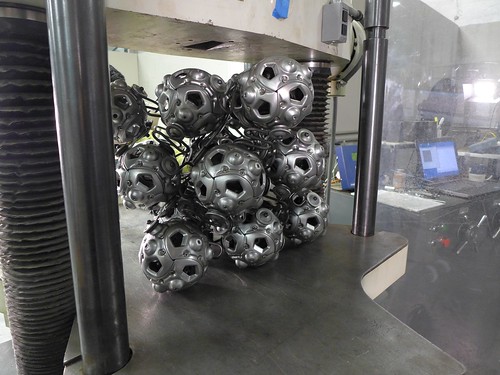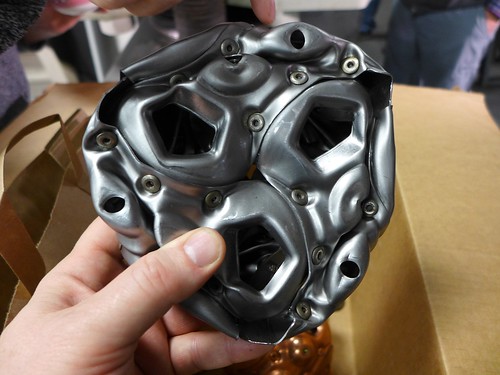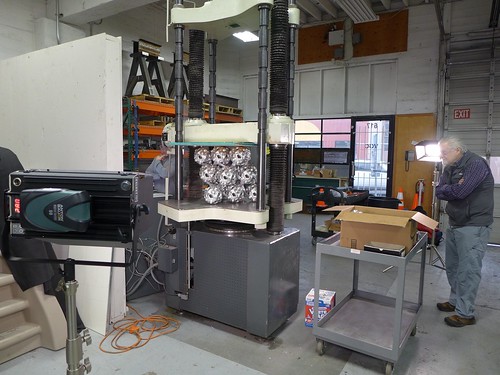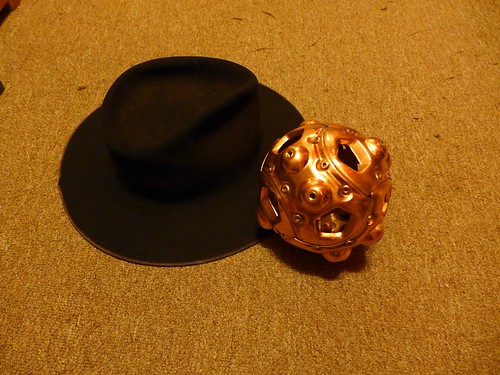Today I rejoined the Flextegrity thread, a company I link to from my Grunch.net page, for some serious stress testing at an engineering firm Sam has worked with before.
My speaking part would come later in the day, when I'd be the focus of the camera. I did have some one liners, and a joke, that the lattice would just spring back into place after all of four thousand pounds of crush.
We'd been mock wagering on the outcomes of these crushing experiments and by this time had seen enough to all know my prognostication was wildly off.
The lattice does spring back after enduring closer to two thousand pounds, once initially stressed to work some kinks out and make it settle (like pre-washing jeans). I'm talking about the steel ball lattice, with the springy joints.
That's right, we were crushing specimens of C6XTY, newly minted, in pure copper, steel and aluminum.
Copper was spared the crushing treatment.
We were not testing alloys in this case.
Those of you up on your metals are likely guess the aluminum failed sooner in the crushing process. You would be right. The schedule included crushing both individual balls and matrices (i.e. lattices) thereof.
I should probably explain what I mean by "a matrix of metal balls," which is what C6XTY might be seen as (the material is not the meat of the matter when it comes to branding; I've only seen plastic versions of C6XTY until recently).
Tension members hold the balls at a set distance from one another, but somewhat flexibly. The substance isn't especially brittle. The lattices didn't splinter apart nor fling particles. Some smaller parts would fall out. Of course we all wore safety glasses.
The two lattices we tested got progressively more deformed, with some detachments here and there. This was feedback for the designers to study. Findings inform future iterations of the flextegrity concept.
I could see driving my truck (had I a truck) over a bridge of C6XTY (were there such a bridge). What a lattice is good for depends on the frequency (scale).
If we drop the scale down to nano, then we might be looking at something naturally occurring. The tension would be provided by the electrical fields themselves, as in crystals. That's more like what I yakked about at the Pauling House.
Having arisen early for this experience, waking to snow outside and taking the buses with Glenn, I was powered by a single cup of coffee. When we got to the tests on the tension members, I excused myself and went to lunch, wanting to be in good shape for the pending interview. My camera battery had died by then.
I'd booked the Linus Pauling House from 1 to 3 PM and that's where and when I got to give more of the bigger picture, from my perspective. Sam invited me to expound.
A philosophy scholar out of Princeton, by 1980 I'd made my way into high school math teaching, and tackled Synergetics, the Bucky Fuller magnum opus and a philosophy. Princeton philosophy wasn't teaching about Synergetics, but this was the kind of dense and difficult prose a philosophy trained reader is supposed to be able to digest.
Thanks to my having taken this turn in my studies, I would encounter, over the years, a network of like-minded, likewise embarked on similar studies. Such was my entre into a small subculture. My presence at this crushing was a long term consequence of my involving myself in a philosophical endeavor.
For example, Kenneth Snelson, a native of Pendleton, Oregon, then a resident of Manhattan, reached out to me in the 1990s, having found I was one of the first and most earnest in getting the Bucky stuff put on the web, the World Wide Web a new invention at the time.
I'd started Synergetics on the Web, now housed behind Grunch.net, and served as the BFI's first webmaster (that's BFI as in Buckminster Fuller Institute -- Kiyoshi and I helped snag the domain name, bfi.org). I did some primitive hand-coded HTML, as a volunteer, creating a first home page.
Kenneth knew if I took Fuller seriously, I'd take "tensegrity" seriously, and that was a term to which Kenneth was attached in a karmic sense. We struck up a friendship and over time I got more familiar with his angle on things. I became his volunteer webmaster as well.
I like to think I helped Kenneth find peace after a disappointing falling out with his mentor Bucky, at Black Mountain College, in part just through knowing he'd found a friend who would listen.
I acknowledged the hurt feelings and we would talk about them, meanwhile debating about his, and Fuller's, future place in history. I like to believe Ed Applewhite spending some time with Kenneth was evidence of my successful diplomacy.
I later (by email) introduced Kenneth to my new friend Sam Lanahan, and later Julian Voss-Andreae. Both got to have some in-person time with Kenneth.
However the story of flextegrity (what Flextegrity the company puts out), does not end with its deriving from tensegrity. Sam had studied Kenneth's work and introduced curvilinear elements, in addition to straight rods.
The flextegrity lattice, in being a lattice, also derives from, or embodies, whatever Alexander Graham Bell was exploring, his "kite" structures, also used to make a tower. Bucky knew the same structure as the "octet truss" (which he patented), and only discovered Bell's work later. Such are the mysterious workings of the zeitgeist.
Crystallographers tend to call this lattice the FCC (face centered cubic) and mathematicians the CCP (cube centric packing). An expanding cuboctahedron. of successive layers (1, 12, 42, 92...), says it all.
Flextegrity the company is about encouraging materials science engineers to join in researching omni-extensible synthetic lattices, one might call them.
One may grow them (weave them) in any direction. Sam's books express this vision.
Think of bricks. Stone masons have long had a space-filling, compression-based model, but it's all about compression. You can't lift brick walls by crane, whereas that's exactly what Sam arranged for in an earlier test of the plastic version.
Concrete with embedded rebar is another load-bearing model.
Flextegrity, the company, would like its lattices to compete in this space, but before that might happen, it needs to crush a few.
The hired videographer was a professional, bringing his own lights on tripods, but new to the whole flextegrity business.
A high degree of ad lib was enjoyed by all around this filming. Sam sat off camera, nudging me with questions and/or reminding me of what I'd left out (such as who I was, and so on). This movie won't be out for some time. I'm glad I got to play a part.




